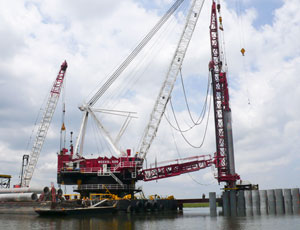A vital storm surge barrier for New Orleans has entered a critical and busy phase.
By mid-summer, more than 100 cranes and supply barges will be positioned to work on the more than $695-million, two-mile long, Inner Harbor Navigation Canal Lake Borgne Surge Barrier project being constructed by the U.S. Army Corps of Engineers in New Orleans.
By May 27, contractors using a single 500-ton crane rig brought in 18 days before, had already driven 62 of the 66-inch diameter, 144-ft-long concrete, spun cast cylinder piles that will form the vertical face of the surge barrier wall. By June 4, the Corps anticipates having a pair of such cranes, working two, 10-hour shifts and driving an estimated 72 piles per week, exceeding their original estimate of 60 piles per week. “We don’t know what will happen with the weather, but so far, it appears we will exceed our original estimate,” Zillmer says.
Considering the fact that real estate acquisitions and changes in navigational gate structures delayed construction by four months, and increased the cost by a not-yet-determined amount, the Corps is happy that pile driving seems to be moving so quickly. “We believe we will have about 50% of the barrier pilings in place by late September or early October,” says Nancy Allen, spokesperson for the Corps’ Hurricane Protection Office.
The 7, 490-ft-long central portion of the roughly two-mile-long project will be comprised of an estimated 1,284 plumb, concrete cylinder piles driven to a depth of 130 ft. which will be backed up by 2,600 square concrete closure piles and 660, 36-inch diameter steel cylinder batter piles, says Charlie Hess, senior vice president of operations for Shaw Environmental & Infrastructure Group, Baton Rouge, the prime contractor. The project also includes a sector gate with a bypass barge gate on the Gulf Intracoastal Waterway, as well as a separate, navigable sector gate on a second channel and rock-reinforced T-wall-style floodwalls.
Looking at the impressive equipment and enormity of the operation, it’s difficult to imagine how it will look later this summer when a virtual “train” of production will be going full steam, says Richmond Kendrick, deputy for program execution for the HPO. At that time, contractors will be performing a variety of activities simultaneously, Kendrick says, including driving batter, plumb and closure piles, as well as stuffing rebar and concrete into the top 85 ft. of the concrete cylinder piles. And that’s not even peak construction, which is anticipated to be January 2010.
“To build the wall, TMW [a joint venture of Traylor Bros., Inc., Evansville, Ind.; Massman Construction Company, St. Louis, Mo. and Weeks Marine, Cranford, N.J.] will require 17 cranes, of varying sizes, working two shifts per day,” Zillmer says. “We will be sucking up a lot of equipment in the height of summer. We’ll also have things like concrete barges that make 25 passes a day to move the 500 yards of concrete we’ll need daily to fill those piles.”
A tugboat is already anchored nearby to serve as traffic director for all of the project-related craft, as well as for delivery vessels en route to nearby businesses and the occasional recreational or commercial fishing boat passing through.
“There is some challenge getting enough skilled operators to work two, 10-hour shifts in both directions, and we’ll need riggers and other operators too,” Zillmer says. Total labor for the whole project is estimated at 2,000 people at peak, with 350 of those working on the water.
In anticipation of the big production push, TMW had scheduled delivery of another huge crane by May 28. At press time, Shaw had not given its sub contractors permission to speak to the media, so the models and sizes of equipment and delivery dates were not available.
“Many factions have been working for quite some time to get us geared up for construction,” Zillmer says. “The reason we can go so fast is most of this is being produced off site.”
Since last year, Gulf Coast Pre-Stress Partners, Ltd., Pass Christian, Miss. and Bayshore Concrete Products Corp., Cape Charles, Va. have been making cylinder concrete piles. GCP has also been making some of the 2,600 square concrete closure piles (18-inch) that will finish the joints between the round, plumb piles. Barges moored nearby hold mountains of the piles, brightly marked with GCP and batch numbers. “We know every single section of pile, where it came from, and what day it was made,” Zillmer says. “Shaw Global is making the 36-inch steel piles at a factory in Florida, and the rebar cages (that will go in the plumb piles) have already been designed.”
Construction is underway of a railroad trestle, which is being constructed adjacent to where the wall will be built. The temporary/sacrificial trestle provides an assembly line setup to align piles in the wall, Zillmer says. Among the parts and pieces visible on the land-based portion of the operation are steel templates for driving trestle pilings, and the bright yellow train segments, fixed with their blue hydraulic motors, that may be linked together to carry any size equipment.
“We wanted to make sure we had sufficient piles when we started because we can put it together faster than production can work,” Zillmer says. “To run this whole operation costs about $1.3 million per day.”
To drive the 66-inch diameter piles, the 500-ton crane holds one in place, making sure it is properly aligned, and lowers it gently into the soft mud, Zillmer explains. “The piles are basically held upright and allowed to sink the first 65 or 70 ft. before they start driving. See that pile? It is going in on its own weight, 96 tons.”
Weep holes are drilled on either side of each pile near the top to allow water and muck to escape at the piles are driven. “When the water starts coming out, they give it 10 or 12 hits and wait for it to drain,” Zillmer says. “When it’s filled up like that, you get more volume inside than out. If they kept driving it, it would shatter the pile.”
The Corps plans to have the entire braced piling wall finished by June 2010, with the three gate structures continuing under construction beyond that date. “It’s a great project,” Zillmer says of what is the largest design build civil works project in the history of the Corps. “How often in life does a person get to work on a project like this, much less be in charge of it?”









Post a comment to this article
Report Abusive Comment